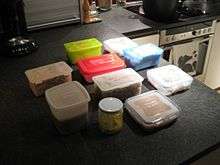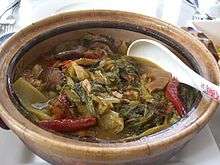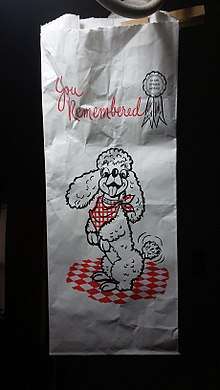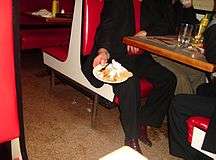Leftovers
Leftovers are foods remaining unconsumed at the end of a meal which are eaten later. Inedible remains like bones are considered waste, not leftovers.

The use of leftovers depends on where the meal was eaten, the preferences of the diner, and the local culture. Leftovers from meals at home are often eaten later. This is facilitated by the private environment and convenience of airtight containers and refrigeration. People may eat leftovers directly from the refrigerator, reheat them, or use them as ingredients to make a new dish.
At restaurants, uneaten food from meals is sometimes taken by diners for later consumption. In the United States, such food is put in a so-called "doggy bag", notionally to feed to pets, whether or not it is in actuality.
Leftover cuisine

New dishes made from leftovers are common in world cuisine. People invented many such dishes before refrigeration and reliable airtight containers existed. Besides capturing nutrition from otherwise inedible bones, stocks and broths provide a base for leftover scraps too small to be a meal themselves. Casseroles,[1] paella, fried rice,[2] Shepherd pies,[3][4] and pizza can also be used for this purpose, and may even have been invented as a means of reusing leftovers. Among American university students, leftover pizza itself has acquired particular in-group significance, to the extent that the USDA's Food Safety and Inspection Service offers, as its first tip under "Food Safety Tips for College Students" by Louisa Graham,[5] a discussion of the considerable risks of eating unrefrigerated pizza.[6]
At some holiday meals, such as Christmas and Thanksgiving in the United States, it is customary to prepare much more food than necessary, specifically so the host can send leftovers home with guests. Cold turkey is archetypal in the United States as a Thanksgiving leftover, with turkey meat often reappearing in sandwiches, soups, and casseroles for several days after the feast.
Leftover portions
Leftovers have had a major impact on the consumption of food, particularly the size of portions. Portion sizes have increased greatly.[7] In general, food leftovers have both positive and negative impacts, depending on the person's eating habits involved with leftovers. With an increase in portion size comes the perception of the amount of intake a particular person considers. For example, a smaller portion usually leads to smaller consumption, making a person believe they have not eaten enough and negatively impacting their eating habits.[8] In turn, a larger portion leads to a greater amount of leftovers, whereas a smaller portion leads to a small amount of leftovers. Through extensive research, one of the most influential factors of weight gain is leftover food and the increased amount of consumption because of it.[9]
Chop suey
The name of the Chinese-American dish chop suey is sometimes translated as "miscellaneous leftovers", although it is unlikely that actual leftovers were served at chop suey restaurants.
Doggy bag

Diners in a restaurant may leave uneaten food for the restaurant to discard, or take it away for later consumption. To take the food away, the diner might request a container, or ask a server to package it. Such a container is colloquially called a doggy bag or doggie bag. This most likely derives from a pretense that the diner plans to give the food to a pet, rather than eat it themselves, and so may be a euphemism. Some also speculate the name was born during World War II when food shortages encouraged people to limit waste, and pet food was scarce.[10] The term doggy bag was popularized in the 1970s etiquette columns of many newspapers.[11] Doggy bags are most common in restaurants that offer a take-out food service as well as sit-down meals, and their prevalence as an accepted social custom varies widely by location. In some countries, especially in Europe, people would frown upon a diner asking for a doggy bag.[12]
Some restaurants wrap leftovers in tin foil, creating shapes such as swans or sea horses.[13]
 Restaurant patron showing his leftovers to be put in a "doggy bag"
Restaurant patron showing his leftovers to be put in a "doggy bag"
References
| Wikimedia Commons has media related to leftovers. |
| Look up leftovers in Wiktionary, the free dictionary. |
- Smith, Andrew F., ed. (2004). Oxford Encyclopedia of Food and Drink in America. 1. New York: Oxford University Press. p. 194.. "With the addition or subtractions of leftovers or inexpensive cuts of meat, the casserole is flexible and economical in terms of both ingredients and effort." (As quoted in Olver, Lynne (2007-06-03). "Food Timeline history notes: ambrosia to corn bread". The Food Timeline. Retrieved 2007-06-05.)
- Olver, Lynne (2006-08-06). "Food Timeline--history notes: Asian-American cuisine". The Food Timeline. Retrieved 2007-06-05.
Fried rice and noodle dishes with vegetables are likewise ancient. They were typically composed of leftover ingriedents and cooked in woks.
- Mrs Beeton's Book of Household Management by Isabella Beeton, 1861.
- Cassell's New Universal Cookery Book by Lizzie Heritage published by Cassell and Company, 1894
- "Food Safety Tips for College Students". 16 June 2013. Retrieved 10 November 2014.
Perishable food should never be left out of refrigeration more than 2 hours. This is true even if there are no meat products on the pizza. Foodborne bacteria that may be present on these foods grow fastest in the "Danger Zone" (temperatures between 40 and 140 °F) and can double in number every 20 minutes.
- "Cold pizza: friend or foe? Food safety in your residence hall". Georgetown University Health Education Services. 2003. Archived from the original on 10 March 2012. Retrieved 2010-05-12.
If a food has been out of the refrigerator for more than two hours, then it is considered unsafe and should be thrown out.
- Krishna, Aradhna (March 2019). "Out of proportion? The role of leftovers in eating-related affect and behavior". Journal of Experimental Social Psychology. 81: 15–26. doi:10.1016/j.jesp.2018.08.005.
- Krishna, Aradhna (March 2019). "Out of proportion? The role of leftovers in eating-related affect and behavior". Journal of Experimental Social Psychology. 81: 15–26. doi:10.1016/j.jesp.2018.08.005.
- Krishna, Aradhna (March 2019). "Out of proportion? The role of leftovers in eating-related affect and behavior". Journal of Experimental Social Psychology. 81: 15–26. doi:10.1016/j.jesp.2018.08.005.
- "doggy bag". The American Heritage Dictionary of the English Language: Fourth Edition. 2000. Retrieved 2007-06-05.
- "The partial triumph of the doggy bag". Retrieved 2010-09-21.
- BBC - Doggy bag: Why are the British too embarrassed to ask? Retrieved 2013-03-26
- Rhodes, Jesse (2011-01-25). "Unwrapping the History of the Doggie Bag". Smithsonian Magazine. Retrieved 2020-03-03.